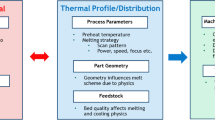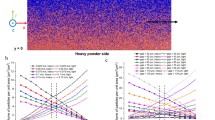Abstract
Powder bed fusion (PBF) process is expeditely moving towards its maturity for the direct manufacturing of intricated and sophisticated metallic parts. The typical process is instead complex and yet challenging to interpret experimentally. Modeling and simulation strategy has been widely implemented to comprehend and optimize the process. Therefore, an integrated simulation approach incorporating stochastic powder deposition and subsequently selective melting is developed to understand the consolidation mechanism in a multilayer process of electron beam PBF additive manufacturing. Simulation results of a thin-walled cross section are validated with the published experimental data to demonstrate the effectiveness of the proposed model. The simulation results of the multilayer process revealed that the layer thickness keeps on slight changes until reaching a steady state during the multilayer additive process. The stable powder layer thickness is systematically analyzed, which proved that the influence of the wall effect should be considered in smaller nominal layer thickness and denser powder bed. Finally, the printing quality in the multilayer process is dependent on adequate inter- and intra-layer bonding when the layer thickness reaches its maximum value, where agglomeration and balling effect in melt pool dynamics predominant by surface tension play crucial roles.















Similar content being viewed by others
Data availability
Not applicable.
Code availability
Not applicable.
References
Gu D, Hagedorn YC, Meiners W, Menga G, Batista RJS, Wissenbach K, Poprawe R (2012) Densification behavior, microstructure evolution, and wear performance of selective laser melting processed commercially pure titanium. Acta Mater 60:3849–3860. https://doi.org/10.1016/j.actamat.2012.04.006
Guo C, Ge W, Lin F (2015) Effects of scanning parameters on material deposition during Electron Beam Selective Melting of Ti-6Al-4V powder. J Mater Process Technol 217:148–157. https://doi.org/10.1016/j.jmatprotec.2014.11.010
Guo C, Lin F, Ge W (2014) Study on the fabrication process of 316L stainless steel via electron beam selective melting. Chin J Mech Eng 50:152–153. https://doi.org/10.3901/JME.2014.21.152
Zafar MQ, Wu C, Zhao H, Wang J, Hu X (2020) Finite element framework for electron beam melting process simulation. Int J Adv Manuf Technol:1–18. https://doi.org/10.1007/s00170-020-05707-x
Khairallah SA, Anderson AT, Rubenchik A, King WE (2016) Laser powder-bed fusion additive manufacturing: Physics of complex melt flow and formation mechanisms of pores, spatter, and denudation zones. Acta Mater 108:36–45. https://doi.org/10.1016/j.actamat.2016.02.014
Körner C, Attar E, Heinl P (2011) Mesoscopic simulation of selective beam melting processes. J Mater Process Technol 211:978–987. https://doi.org/10.1016/j.jmatprotec.2010.12.016
Körner C, Bauereiß A, Attar E (2013) Fundamental consolidation mechanisms during selective beam melting of powders. Model Simul Mater Sci Eng 21:85011. https://doi.org/10.1088/0965-0393/21/8/085011
Rausch AM, Küng VE, Pobel C, Markl M, Körner C (2017) Predictive simulation of process windows for powder bed fusion additive manufacturing: influence of the powder bulk density. Materials 10:1117. https://doi.org/10.3390/ma10101117
Yan W, Ge W, Qian Y, Lin S, Zhou B, Liu WK, Lin F, Wagner GJ (2017) Multi-physics modeling of single/multiple-track defect mechanisms in electron beam selective melting. Acta Mater 134:324–333. https://doi.org/10.1016/j.actamat.2017.05.061
Yan W, Qian Y, Ge W, Lin S, Liu WK, Lin F, Wagner GJ (2018) Meso-scale modeling of multiple-layer fabrication process in selective electron beam melting: inter-layer/track voids formation. Mater Des 141:210–219. https://doi.org/10.1016/j.matdes.2017.12.031
Chen H, Wei Q, Zhang Y, Chen F, Shi Y, Yan W (2019) Powder-spreading mechanisms in powder-bed-based additive manufacturing: experiments and computational modeling. Acta Mater 179:158–171. https://doi.org/10.1016/j.actamat.2019.08.030
Haeri S, Wang Y, Ghita O, Sun J (2017) Discrete element simulation and experimental study of powder spreading process in additive manufacturing. Powder Technol 306:45–54. https://doi.org/10.1016/j.powtec.2016.11.002
Lee YS, Nandwana P, Zhang W (2018) Dynamic simulation of powder packing structure for powder bed additive manufacturing. Int J Adv Manuf Technol 96:1507–1520. https://doi.org/10.1007/s00170-018-1697-3
Han Q, Gu H, Setchi R (2019) Discrete element simulation of powder layer thickness in laser additive manufacturing. Powder Technol 352:91–102. https://doi.org/10.1016/j.powtec.2019.04.057
Haeri S (2017) Optimisation of blade type spreaders for powder bed preparation in additive manufacturing using DEM simulations. Powder Technol 321:94–104. https://doi.org/10.1016/j.powtec.2017.08.011
Meakin P, Jullien R (1987) Restructuring effects in the rain model for random deposition. J Phys 48:1651–1662. https://doi.org/10.1051/jphys:0198700480100165100
Mindt HW, Megahed M, Lavery NP, Holmes MA, Brown SGR (2016) Powder bed layer characteristics: the overseen first-order process input. Metall Mater Trans A 47:3811–3822. https://doi.org/10.1007/s11661-016-3470-2
Krzyzanowski M, Svyetlichnyy D, Stevenson G, Rainforth WM (2016) Powder bed generation in integrated modelling of additive layer manufacturing of orthopaedic implants. Int J Adv Manuf Technol 87:519–530. https://doi.org/10.1007/s00170-016-8491-x
Venuvinod PK, Ma W (2013) Rapid prototyping: laser-based and other technologies. Springer Science & Business Media. https://doi.org/10.1007/978-1-4757-6361-4
Wischeropp TM, Emmelmann C, Brandt M, Pateras A (2019) Measurement of actual powder layer height and packing density in a single layer in selective laser melting. Addit Manuf 28:176–183. https://doi.org/10.1016/j.addma.2019.04.019
Spierings AB, Herres N, Levy G (2011) Influence of the particle size distribution on surface quality and mechanical properties in AM steel parts. Rapid Prototyp J 17(3):195–202. https://doi.org/10.1108/13552541111124770
Markl M, Körner C (2018) Powder layer deposition algorithm for additive manufacturing simulations. Powder Technol 330:125–136. https://doi.org/10.1016/j.powtec.2018.02.026
Meier C, Weissbach R, Weinberg J, Wall WA, Hart AJ (2019) Modeling and characterization of cohesion in fine metal powders with a focus on additive manufacturing process simulations. Powder Technol 343:855–866. https://doi.org/10.1016/j.powtec.2018.11.072
Lumay G, Boschini F, Traina K, Bontempi S, Remy JC, Cloots R, Vandewalle N (2012) Measuring the flowing properties of powders and grains. Powder Technol 224:19–27. https://doi.org/10.1016/j.powtec.2012.02.015
Batchelor CK, Batchelor GK (2000) An introduction to fluid dynamics. Cambridge university press. https://doi.org/10.1017/CBO9780511800955
Zhao H, Niu W, Zhang B, Lei Y, Kodama M, Ishide T (2011) Modelling of keyhole dynamics and porosity formation considering the adaptive keyhole shape and three-phase coupling during deep-penetration laser welding. J Phys D Appl Phys 44:485302. https://doi.org/10.1088/0022-3727/44/48/485302
Zhao H, He L, Niu WC, Zhang B (2016) Investigation on porosity suppression in deep-penetration laser welding by using computational fluid dynamics. J Laser Appl 28:32011. https://doi.org/10.2351/1.4953065
He L, Zhao H, Niu W (2018) Understanding the effect of oxygen on weld pool and keyhole in laser beam welding. J Laser Appl 30:12003. https://doi.org/10.2351/1.5017703
Yan W, Smith J, Ge W, Lin F, Liu WK (2015) Multiscale modeling of electron beam and substrate interaction: a new heat source model. Comput Mech 56:265–276. https://doi.org/10.1007/s00466-015-1170-1
Scardovelli R, Zaleski S (2000) Analytical relations connecting linear interfaces and volume fractions in rectangular grids. J Comput Phys 164:228–237. https://doi.org/10.1006/jcph.2000.6567
Ahn J, Na S-J (2013) Three-dimensional thermal simulation of nanosecond laser ablation for semitransparent material. Appl Surf Sci 283:115–127. https://doi.org/10.1016/j.apsusc.2013.06.048
Eggers J (1997) Nonlinear dynamics and breakup of free-surface flows. Rev Mod Phys 69:865–930. https://doi.org/10.1103/RevModPhys.69.865
Carslaw HS, Jaeger JC (1959) Conduction of heat in solids 2nd ed. Oxford: The Clarendon Press.
Acknowledgements
The authors would like to thank Miss. Feng Zhou for her cooperation in preparing illustrations.
Funding
This work is supported by the National Key R&D Program of China (No. 2017YFB1103300); Funding of State Key Lab of Tribology, Tsinghua University (No. SKLT2018B06); and National Natural Science Foundation of China (No. 51975320).
Author information
Authors and Affiliations
Contributions
Chaochao Wu: methodology, software, investigation, visualization, writing—original draft. Muhammad Qasim Zafar: writing—review and editing. Haiyan Zhao: conceptualization, supervision, project administration.
Corresponding author
Ethics declarations
Ethics approval
Not applicable.
Consent to participate
Not applicable.
Consent for publication
All the authors agree with the publication..
Competing interests
The authors declare that they have no competing interests.
Additional information
Publisher’s note
Springer Nature remains neutral with regard to jurisdictional claims in published maps and institutional affiliations.
Rights and permissions
About this article
Cite this article
Wu, C., Zafar, M.Q. & Zhao, H. Numerical investigation of consolidation mechanism in powder bed fusion considering layer characteristics during multilayer process. Int J Adv Manuf Technol 113, 2087–2100 (2021). https://doi.org/10.1007/s00170-021-06768-2
Received:
Accepted:
Published:
Issue Date:
DOI: https://doi.org/10.1007/s00170-021-06768-2




